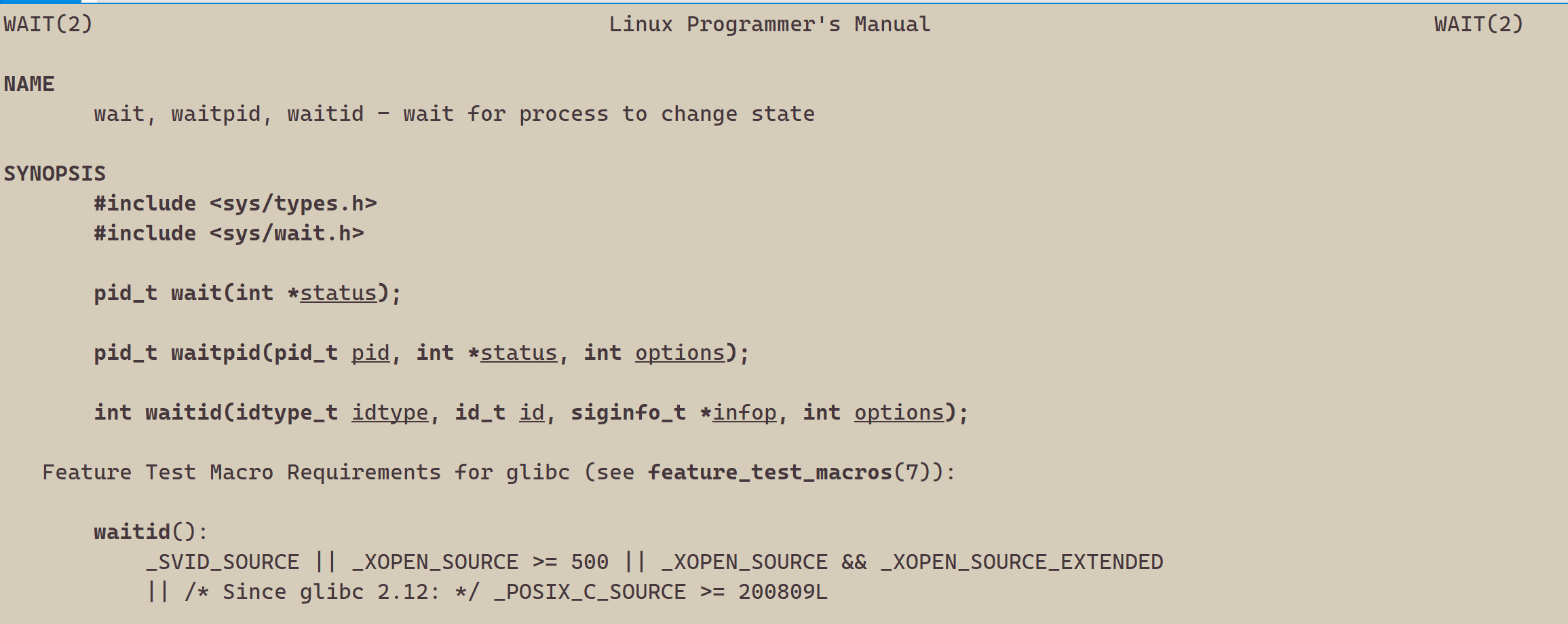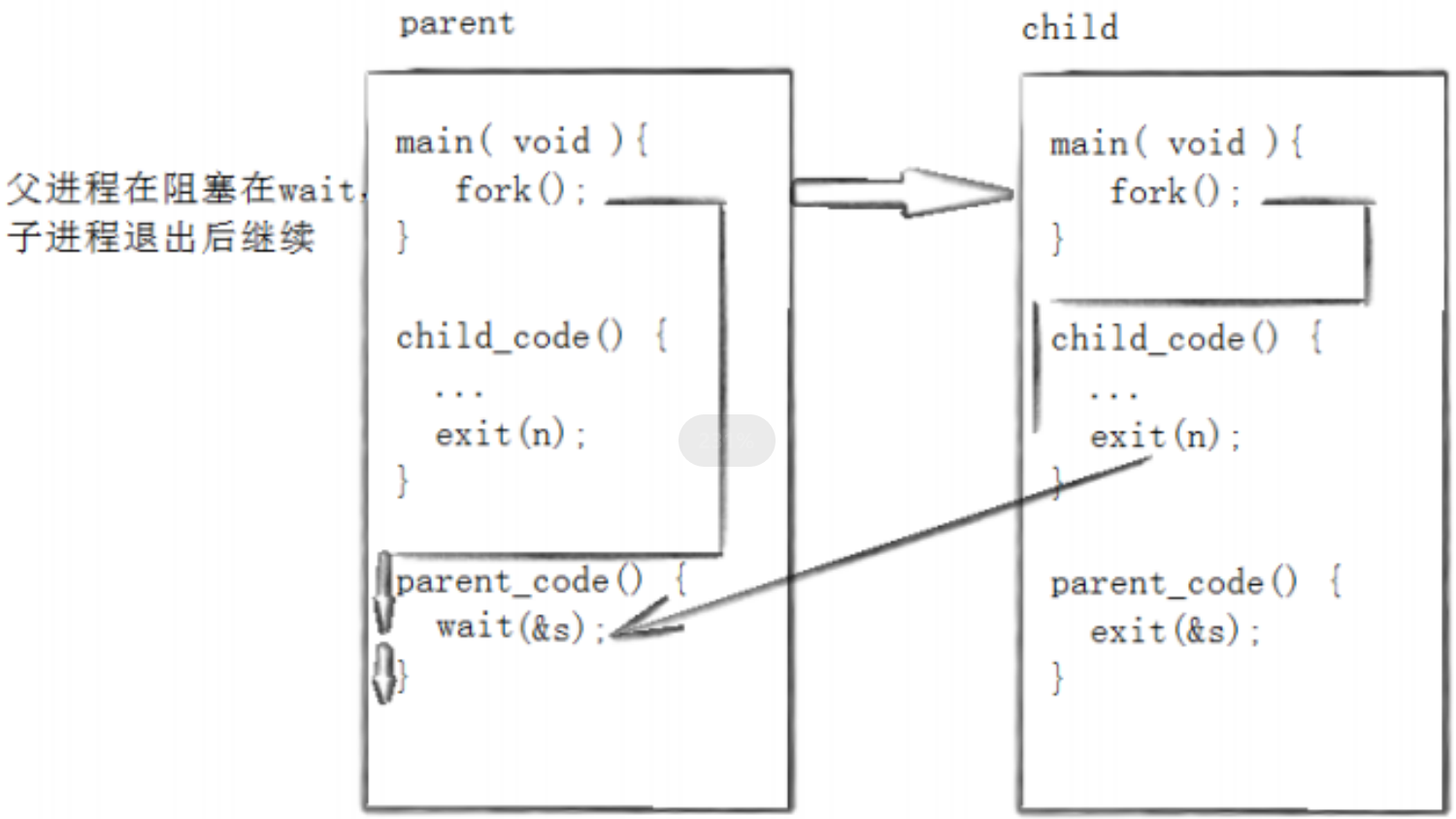
文章目录
- 一、为什么要进程等待
- 二、进程等待的方法
- 1、wait方法
- 2、waitpid方法
- 三、获取子进程status
一、为什么要进程等待
- 解决子进程僵尸问题带来的内存泄漏
- 为了获取子进程退出信息
二、进程等待的方法
1、wait方法
wait介绍

#include<sys/types.h>
#include<sys/wait.h>
pid_t wait(int*status);
//返回值://成功返回被等待进程pid,失败返回-1。
//参数://输出型参数,获取子进程退出状态,不关心则可以设置成为NULL
2、waitpid方法
waitpid介绍

返回值:
当正常返回的时候waitpid返回收集到的子进程的进程ID;
如果设置了选项WNOHANG,而调用中waitpid发现没有已退出的子进程可收集,则返回0;
如果调用中出错,则返回-1,这时errno会被设置成相应的值以指示错误所在;
参数:
pid:
Pid=-1,等待任一个子进程。与wait等效。
Pid>0.等待其进程ID与pid相等的子进程。
status:
WIFEXITED(status): 若为正常终止子进程返回的状态,则为真。(查看进程是否是正常退出)
WEXITSTATUS(status): 若WIFEXITED非零,提取子进程退出码。(查看进程的退出码)
options:
WNOHANG: 若pid指定的子进程没有结束,则waitpid()函数返回0,不予以等待。若正常结束,则返回该子进
程的ID。
如果子进程已经退出,调用wait/waitpid时,wait/waitpid会立即返回,并且释放资源,获得子进程退
出信息。
如果在任意时刻调用wait/waitpid,子进程存在且正常运行,则进程可能阻塞。
如果不存在该子进程,则立即出错返回。

三、获取子进程status
wait和waitpid,都有一个status参数,该参数是一个输出型参数,由操作系统填充。
如果传递NULL,表示不关心子进程的退出状态信息。否则,操作系统会根据该参数,将子进程的退出信息反馈给父进程。
status不能简单的当作整形来看待,可以当作位图来看待,具体细节如下图(只研究status低16比特
位):

测试代码:
#include <sys/wait.h>
#include <stdio.h>
#include <stdlib.h>
#include <string.h>
#include <errno.h>
int main()
{pid_t pid;if ( (pid=fork()) == -1 )perror("fork"),exit(1);if ( pid == 0 ){sleep(20);exit(10);} else {int st;int ret = wait(&st);if ( ret > 0 && ( st & 0X7F ) == 0 ){ // 正常退出printf("child exit code:%d\n", (st>>8)&0XFF);} else if( ret > 0 ) { // 异常退出printf("sig code : %d\n", st&0X7F );}}
}
具体代码实现
进程的阻塞等待方式:
int main()
{pid_t pid;pid = fork();if(pid < 0){printf("%s fork error\n",__FUNCTION__);return 1;} else if( pid == 0 ){ //childprintf("child is run, pid is : %d\n",getpid());sleep(5);exit(257);} else{int status = 0;pid_t ret = waitpid(-1, &status, 0);//阻塞式等待,等待5Sprintf("this is test for wait\n");if( WIFEXITED(status) && ret == pid ){printf("wait child 5s success, child return code is :%d.\n",WEXITSTATUS(status));}else{printf("wait child failed, return.\n");return 1;}}return 0;
}
进程的非阻塞等待方式:
#include <stdio.h>
#include <unistd.h>
#include <stdlib.h>
#include <sys/wait.h>
int main()
{pid_t pid;pid = fork();if(pid < 0){printf("%s fork error\n",__FUNCTION__);return 1;}else if( pid == 0 ){ //childprintf("child is run, pid is : %d\n",getpid());sleep(5);exit(1);} else{int status = 0;pid_t ret = 0;do{ret = waitpid(-1, &status, WNOHANG);//非阻塞式等待if( ret == 0 ){printf("child is running\n");}sleep(1);}while(ret == 0);if( WIFEXITED(status) && ret == pid ){printf("wait child 5s success, child return code is :%d.\n",WEXITSTATUS(status));}else{printf("wait child failed, return.\n");return 1;}}return 0;
}





)








)
名字空间 | 超详细名字空间解析 内置 全局 局部 调试查看)
)

)
: 渲染基础)